Low-Cost Benzene Toluene Xylene Measurement Gas System Based on the Mini Chromatographic Cartridge
Abstract
:1. Introduction
2. Materials and Methods
2.1. Measurement System Development
- Each chromatographic column segment, 100 mm long, was cut from the whole column by using a capillary GC column cutter.
- A cleaned glass tube, 80 mm long, having an inner and outer diameter of 5.5 mm and 7 mm, respectively, was filled with 44 column segments.
- Polyimide sealing resin (23,817 by Supelco) was used to fill all interstices between both the glass tube and the columns and between the columns themselves. Moreover, the resin was abundantly applied to the two extremities of the cartridge to facilitate the final cutting process.
- A diamond rotary saw was employed to cut the cartridge, in order to obtain a total length of 80 mm.
- A flexible heater was rolled up around the PCC and a Resistance Temperature Detector (RTD) model PT1000) was inserted to control the PCC temperature (see Figure 4a).
2.2. Measurement System Testing
3. Results and Discussion
4. Conclusions
Author Contributions
Funding
Institutional Review Board Statement
Informed Consent Statement
Data Availability Statement
Acknowledgments
Conflicts of Interest
References
- WHO. Selected Pollutants (WHO Guidelines for Indoor Air Quality); WHO: Geneva, Switzerland, 2010; ISBN 978-92-890-0213-4. [Google Scholar]
- Kim, D.; Chen, Z.; Zhou, L.-F.; Huang, S. Air pollutants and early origins of respiratory diseases. Chronic Dis. Transl. Med. 2018, 4, 75–94. [Google Scholar] [CrossRef] [PubMed]
- Szczurek, A.; Maziejuk, M.; Maciejewska, M.; Pietrucha, T.; Sikora, T. BTX compounds recognition in humid air using differential ion mobility spectrometry combined with a classifier. Sens. Actuators B Chem. 2017, 240, 1237–1244. [Google Scholar] [CrossRef]
- Kim, K.-H.; Pandey, S.K.; Pal, R. Analytical bias among different gas chromatographic approaches using standard BTX gases and exhaust samples. J. Sep. Sci. 2009, 32, 549–558. [Google Scholar] [CrossRef] [PubMed]
- Schnatter, A.R.; Kerzic, P.J.; Zhou, Y.; Chen, M.; Nicolich, M.J.; Lavelle, K.; Armstrong, T.W.; Bird, M.; Lin, L.; Fu, H.; et al. Peripheral blood effects in benzene-exposed workers. Chem. Interact. 2010, 184, 174–181. [Google Scholar] [CrossRef]
- Masih, A.; Lall, A.; Taneja, A.; Singhvi, R. Exposure levels and health risk assessment of ambient BTX at urban and rural environments of a terai region of northern India. Environ. Pollut. 2018, 242, 1678–1683. [Google Scholar] [CrossRef]
- Wilbur, S.B.; Keith, S.; Faroon, O.; Wohlers, D. Toxicological Profile for Benzene; Agency for Toxic Substances and Disease Registry: Atlanta, GA, USA, 2007.
- Gallego, E.; Roca, F.; Guardino, X.; Rosell, M. Indoor and outdoor BTX levels in Barcelona City metropolitan area and Catalan rural areas. J. Environ. Sci. 2008, 20, 1063–1069. [Google Scholar] [CrossRef]
- Mirzaei, A.; Leonardi, S.G.; Neri, G. Detection of hazardous volatile organic compounds (VOCs) by metal oxide nanostruc-tures-based gas sensors: A review. Ceram. Int. 2016. [Google Scholar] [CrossRef]
- Thammakhet, C.; Muneesawang, V.; Thavarungkul, P.; Kanatharana, P. Cost effective passive sampling device for volatile organic compounds monitoring. Atmos. Environ. 2006, 40, 4589–4596. [Google Scholar] [CrossRef]
- Thammakhet, C.; Villeneuve, T.; Munisawang, V.; Thavarungkul, P.; Kanatharana, P. Monitoring of BTX by passive sampling in Hat Yai. J. Sci. Technol. 2004, 26, 151–160. [Google Scholar]
- Du, Z.; Mo, J.; Zhang, Y.; Li, X.; Xu, Q. Evaluation of a new passive sampler using hydrophobic zeolites as adsorbents for exposure measurement of indoor BTX. Anal. Methods 2013, 5, 3463. [Google Scholar] [CrossRef]
- Szulczyński, B.; Gębicki, J. Currently Commercially Available Chemical Sensors Employed for Detection of Volatile Organic Compounds in Outdoor and Indoor Air. Environments 2017, 4, 21. [Google Scholar] [CrossRef] [Green Version]
- Spinelle, L.; Gerboles, M.; Kok, G.; Persijn, S.; Sauerwald, T. Review of Portable and Low-Cost Sensors for the Ambient Air Monitoring of Benzene and Other Volatile Organic Compounds. Sensors 2017, 17, 1520. [Google Scholar] [CrossRef] [PubMed] [Green Version]
- Su, Y.; Yang, T.; Zhao, X.; Cai, Z.; Chen, G.; Yao, M.; Chen, K.; Bick, M.; Wang, J.; Li, S.; et al. A wireless energy transmission enabled wearable active acetone biosensor for non-invasive prediabetes diagnosis. Nano Energy 2020, 74, 104941. [Google Scholar] [CrossRef]
- Persaud, K.C. Polymers for chemical sensing. Mater. Today 2005, 8, 38–44. [Google Scholar] [CrossRef]
- Fratoddi, I.; Altamura, P.; Bearzotti, A.; Furlani, A.; Russo, M. Electrical and morphological characterization of poly(monosubstituted)acetylene based membranes: Application as humidity and organic vapors sensors. Thin Solid Films 2004, 458, 292–298. [Google Scholar] [CrossRef]
- Li, W.; Wu, X.; Han, N.; Chen, J.; Qian, X.; Deng, Y.; Tang, W.; Chen, Y. MOF-derived hierarchical hollow ZnO nanocages with enhanced low-concentration VOCs gas-sensing performance. Sens. Actuators B Chem. 2016, 225, 158–166. [Google Scholar] [CrossRef]
- Huang, H.; Xu, P.; Zheng, D.; Chen, C.; Li, X. Sulfuration–desulfuration reaction sensing effect of intrinsic ZnO nanowires for high-performance H2S detection. J. Mater. Chem. A 2014, 3, 6330–6339. [Google Scholar] [CrossRef]
- Manzo, C.; Mei, A.; Zampetti, E.; Bassani, C.; Paciucci, L.; Manetti, P. Top-down approach from satellite to terrestrial rover application for environmental monitoring of landfills. Sci. Total Environ. 2017, 1333–1348. [Google Scholar] [CrossRef]
- Mirzaei, A.; Kim, J.H.; Kim, H.W.; Kim, S.S. Resistive-based gas sensors for detection of benzene, toluene and xylene (BTX) gases: A review. J. Mater. Chem. C 2018, 6, 4342–4370. [Google Scholar] [CrossRef]
- Bearzotti, A.; Macagnano, A.; Papa, P.; Venditti, I.; Zampetti, E. A study of a QCM sensor based on pentacene for the detection of BTX vapors in air. Sens. Actuators B Chem. 2017, 240, 1160–1164. [Google Scholar] [CrossRef]
- Viespe, C.; Grigoriu, C. Surface acoustic wave sensors with carbon nanotubes and SiO2/Si nanoparticles based nanocomposites for VOC detection. Sens. Actuators B Chem. 2010, 147, 43–47. [Google Scholar] [CrossRef]
- Penza, M.; Antolini, F.; Antisari, M. Carbon nanotubes as SAW chemical sensors materials. Sens. Actuators B Chem. 2004, 100, 47–59. [Google Scholar] [CrossRef]
- De Cesare, F.; Di Mattia, E.; Pantalei, S.; Zampetti, E.; Vinciguerra, V.; Canganella, F.; Macagnano, A. Use of electronic nose technology to measure soil microbial activity through biogenic volatile organic compounds and gases release. Soil Biol. Biochem. 2011, 43, 2094–2107. [Google Scholar] [CrossRef] [Green Version]
- Hamdi, K.; Hébrant, M.; Martin, P.; Galland, B.; Etienne, M. Mesoporous silica nanoparticle film as sorbent for in situ and real-time monitoring of volatile BTX (benzene, toluene and xylenes). Sens. Actuators B Chem. 2016, 223, 904–913. [Google Scholar] [CrossRef]
- Hue, J.; Dupoy, M.; Bordy, T.; Rousier, R.; Vignoud, S.; Schaerer, B.; Tran-Thi, T.-H.; Rivron, C.; Mugherli, L.; Karpe, P. Benzene and xylene detection by absorbance in the range of 10–100ppb application: Quality of indoor air. Sens. Actuators B Chem. 2013, 189, 194–198. [Google Scholar] [CrossRef]
- Camou, S.; Shimizu, A.; Horiuchi, T.; Haga, T. ppb-Level detection of benzene diluted in water with portable device based on bubbling extraction and UV spectroscopy. Sens. Actuators B Chem. 2008, 132, 601–607. [Google Scholar] [CrossRef]
- Azzouz, A.; Vikrant, K.; Kim, K.-H.; Ballesteros, E.; Rhadfi, T.; Malik, A.K. Advances in colorimetric and optical sensing for gaseous volatile organic compounds. TrAC Trends Anal. Chem. 2019, 118, 502–516. [Google Scholar] [CrossRef]
- Khan, S.; Le Calvé, S.; Newport, D. A review of optical interferometry techniques for VOC detection. Sens. Actuators A Phys. 2020. [Google Scholar] [CrossRef]
- Peng, F.-M.; Xie, P.; Li, H.; Zhang, Y.-H.; Wang, J.-D.; Liu, W.-Q. Effect of Atmospheric Interfering Absorption on Measurement of BTX by DOAS. Chin. J. Chem. Phys. 2008, 21, 202–210. [Google Scholar] [CrossRef] [Green Version]
- Oser, H.; Coggiola, M.J.; Young, S.E.; Crosley, D.R.; Hafer, V.; Grist, G. Membrane introduction/laser photoionization time-of-flight mass spectrometry. Chemosphere 2007, 67, 1701–1708. [Google Scholar] [CrossRef]
- Bottein, M.-Y.D.; Fuquay, J.M.; Munday, R.; Selwood, A.I.; Van Ginkel, R.; Miles, C.; Loader, J.I.; Wilkins, A.L.; Ramsdell, J.S. Bioassay methods for detection of N-palmitoylbrevetoxin-B2 (BTX-B4). Toxicon 2010, 55, 497–506. [Google Scholar] [CrossRef] [PubMed]
- Grob, R.L.; Barry, E.F. (Eds.) Modern Practice of Gas Chromatography; Wiley: Hoboken, NJ, USA, 2004. [Google Scholar]
- Snyder, L.R.; Kirkland, J.J.; Dolan, J.W. Introduction to Modern Liquid Chromatography; Wiley: Hoboken, NJ, USA, 2009. [Google Scholar]
- Poole, C. Gas Chromatography; Elsevier: Amsterdam, The Netherlands, 2012. [Google Scholar]
- Bahrami, A.; Mahjub, H.; Sadeghian, M.; Golbabaei, F. Determination of Benzene, Toluene and Xylene (BTX) Concentrations in Air Using HPLC Developed Method Compared to Gas Chromatography. Int. J. Occup. Hyg. 2011, 3, 12–17. [Google Scholar]
- Grametbauer, P.; Kartusek, S.; Hausner, O. Diagnosis of aerobic gram-negative bacteria by the detection of volatile metabolites using gas chromatography. Mikrobiol. Imunol. 1988, 37, 216–223. [Google Scholar]
- Phillips, M. Method for the Collection and Assay of Volatile Organic Compounds in Breath. Anal. Biochem. 1997, 247, 272–278. [Google Scholar] [CrossRef] [Green Version]
- Saka, M. Application of gas chromatograph with selected detector for pesticide residue analysis in food. J. Pestic. Sci. 2010, 35, 580–586. [Google Scholar] [CrossRef] [Green Version]
- Wang, Z. Fate and Identification of Spilled Oils and Petroleum Products in the Environment by GC-MS and GC-FID. Energy Sources 2003, 25, 491–508. [Google Scholar] [CrossRef]
- Wu, B.-Z.; Feng, T.-Z.; Sree, U.; Chiu, K.-H.; Lo, J.-G. Sampling and analysis of volatile organics emitted from wastewater treatment plant and drain system of an industrial science park. Anal. Chim. Acta 2006, 576, 100–111. [Google Scholar] [CrossRef]
- Dziuban, J.; Mroz, J.; Szczygielska, M.; Małachowski, M.; Gorecka-Drzazga, A.; Walczak, R.; Buła, W.; Zalewski, D.; Nieradko, Ł.; Łysko, J.; et al. Portable gas chromatograph with integrated components. Sens. Actuators A Phys. 2004, 115, 318–330. [Google Scholar] [CrossRef]
- Radadia, A.D.; Morgan, R.D.; Masel, R.; Shannon, M.A. Partially Buried Microcolumns for Micro Gas Analyzers. Anal. Chem. 2009, 81, 3471–3477. [Google Scholar] [CrossRef]
- Kaanta, B.C.; Chen, H.; Zhang, X. A monolithically fabricated gas chromatography separation column with an integrated high sensitivity thermal conductivity detector. J. Micromech. Microeng. 2010, 20. [Google Scholar] [CrossRef]
- Agah, M.; Wise, K.D. Low-Mass PECVD Oxynitride Gas Chromatographic Columns. J. Microelectromech. Syst. 2007, 16, 853–860. [Google Scholar] [CrossRef]
- Zampolli, S.; Elmi, I.; Cardinali, G.C.; Masini, L.; Bonafè, F.; Zardi, F. Compact-GC platform: A flexible system integration strategy for a completely microsystems-based gas-chromatograph. Sens. Actuators B Chem. 2020, 305, 127444. [Google Scholar] [CrossRef]
- Kalsoom, U.; Nesterenko, P.; Paull, B. Current and future impact of 3D printing on the separation sciences. TrAC Trends Anal. Chem. 2018, 105, 492–502. [Google Scholar] [CrossRef]
- Contreras, J.A.; Murray, J.A.; Tolley, S.E.; Oliphant, J.L.; Tolley, H.D.; Lammert, S.A.; Lee, E.D.; Later, D.W.; Lee, M.L. Hand-Portable Gas Chromatograph-Toroidal Ion Trap Mass Spectrometer (GC-TMS) for Detection of Hazardous Compounds. J. Am. Soc. Mass Spectrom. 2008, 19, 1425–1434. [Google Scholar] [CrossRef] [Green Version]
- Mini GC Plus, by Vernier. Available online: https://www.vernier.com (accessed on 27 December 2020).
- Torion T-9 Portable GC/MS, by PerkinElmer. Available online: www.perkinelmer.com (accessed on 27 December 2020).
- Mini GC, by Forston Labs. Available online: https://www.analyticalwest.com/mini-gc.html (accessed on 27 December 2020).
- NIST Chemistry WebBook. Available online: https://www.nist.gov/ (accessed on 27 December 2020).
- Wahab, M.F.; Patel, D.C.; Armstrong, D.W. Total peak shape analysis: Detection and quantitation of concurrent fronting, tailing, and their effect on asymmetry measurements. J. Chromatogr. A 2017, 1509, 163–170. [Google Scholar] [CrossRef]
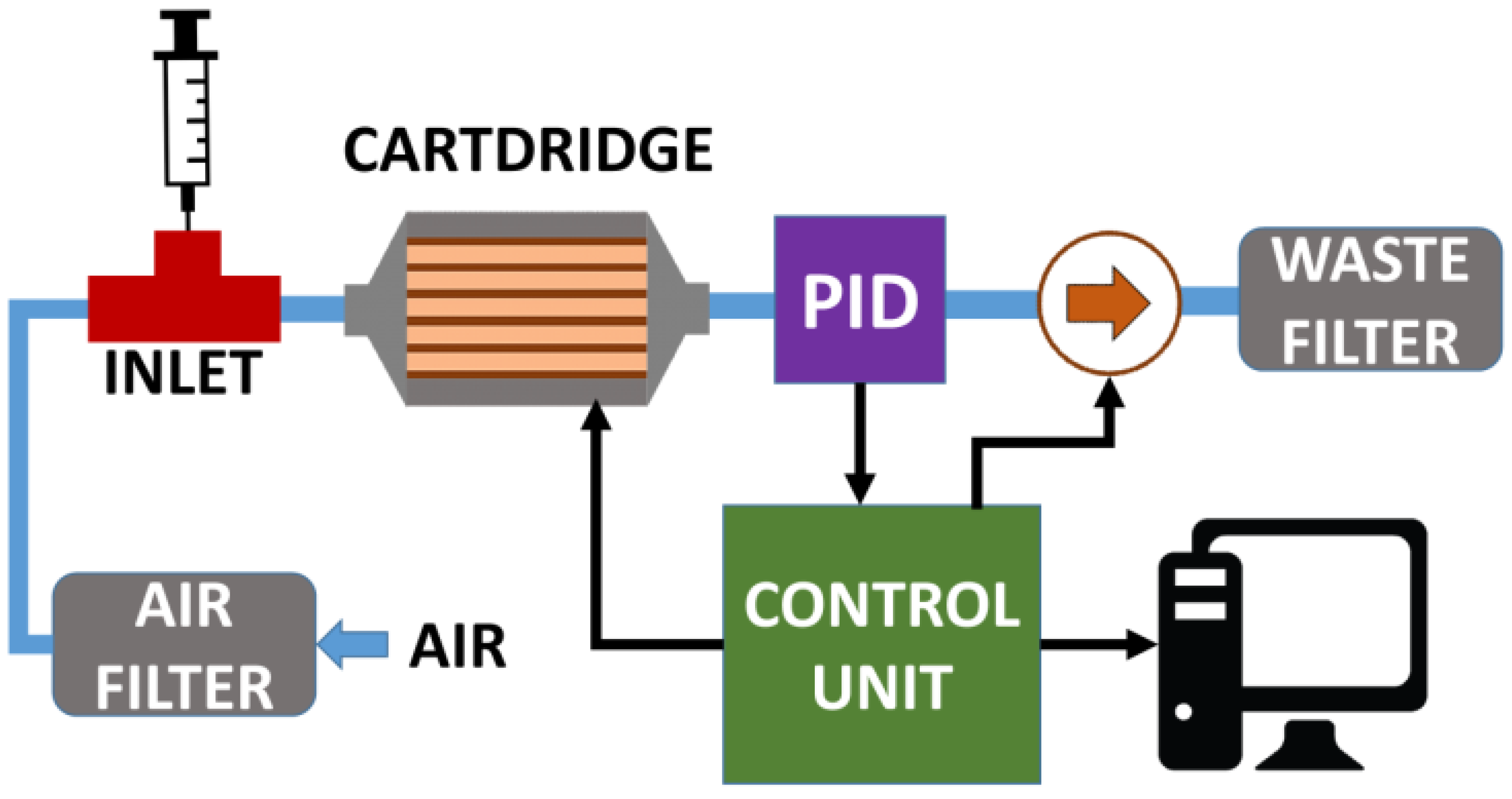
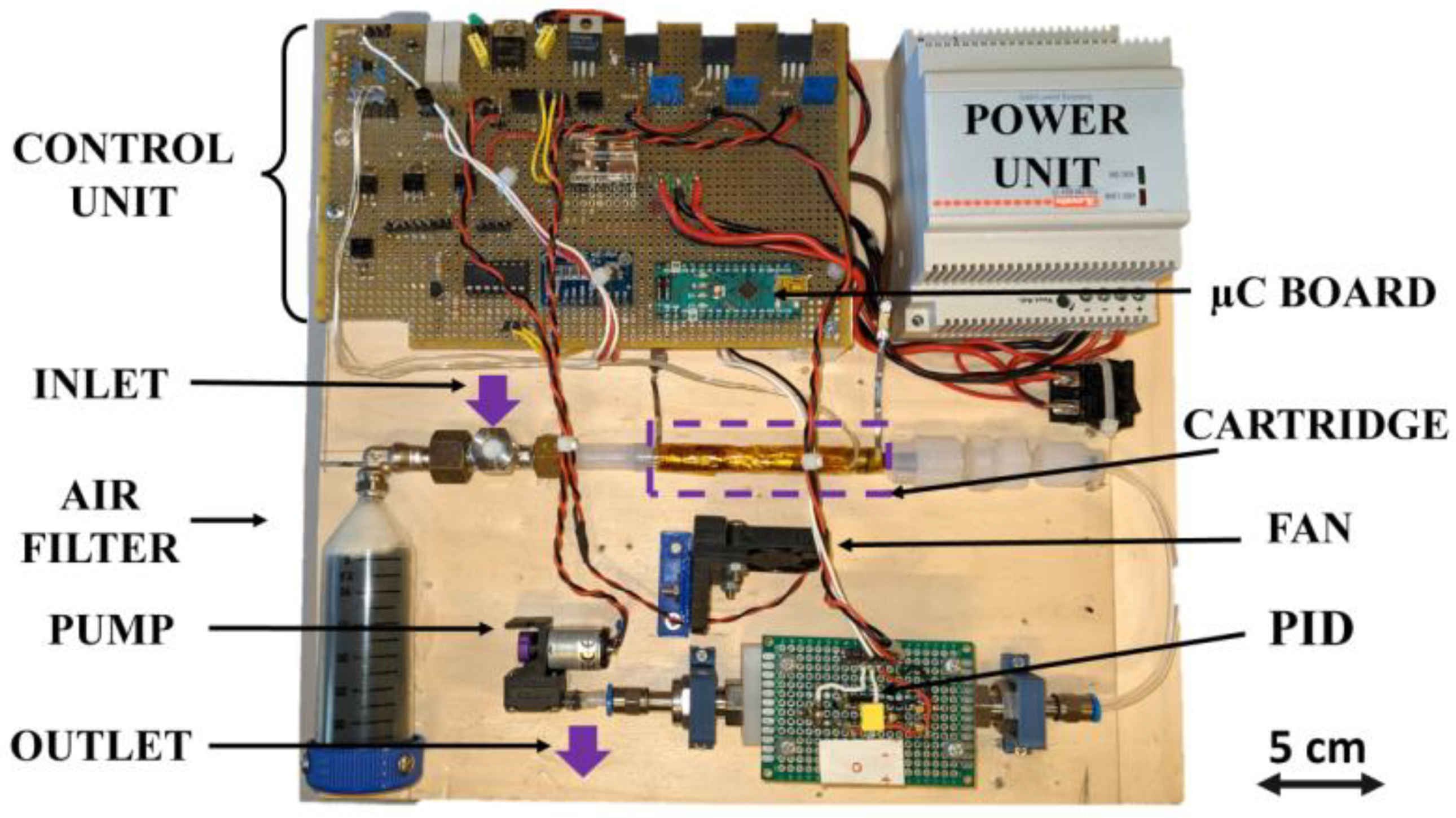
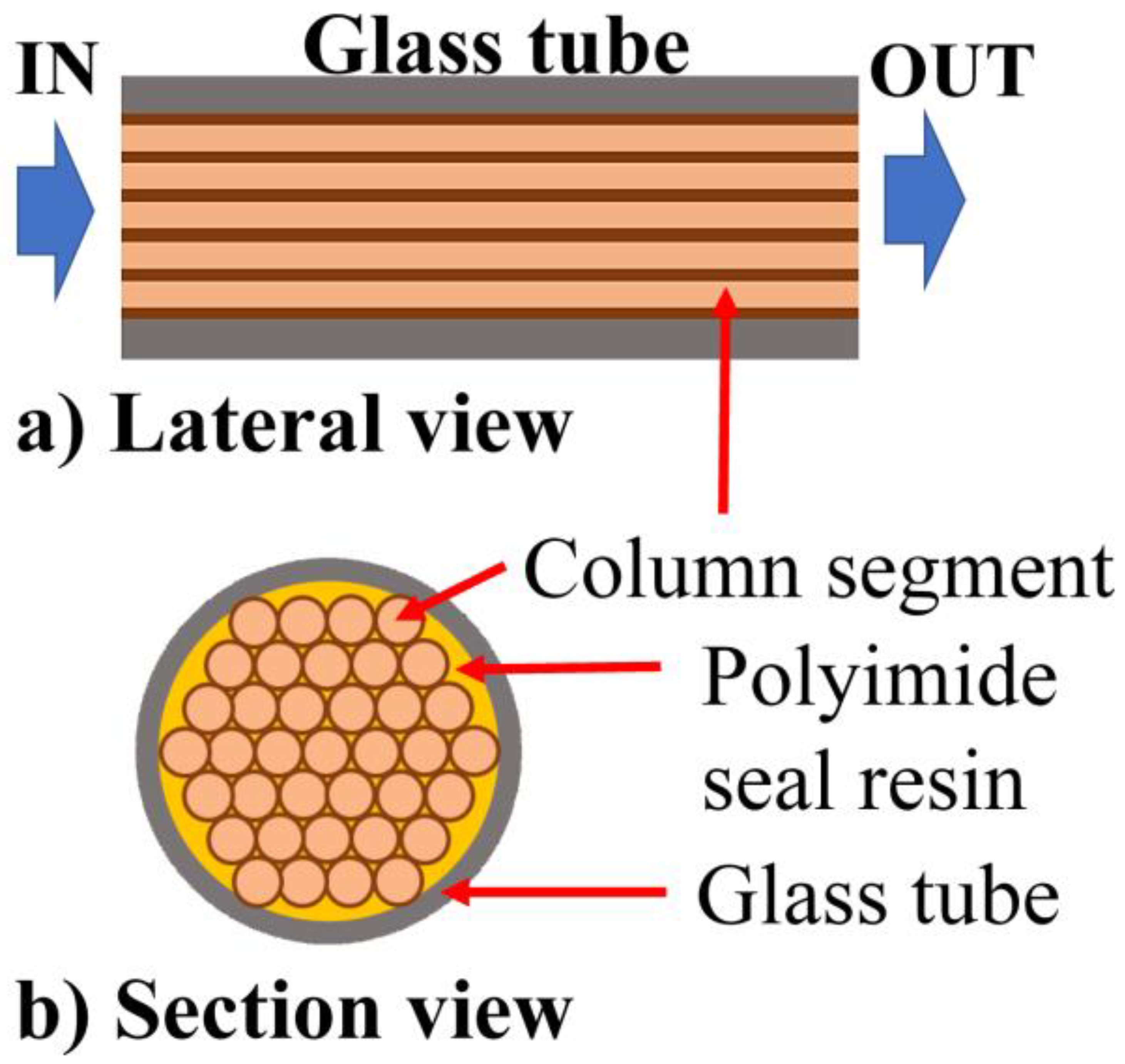
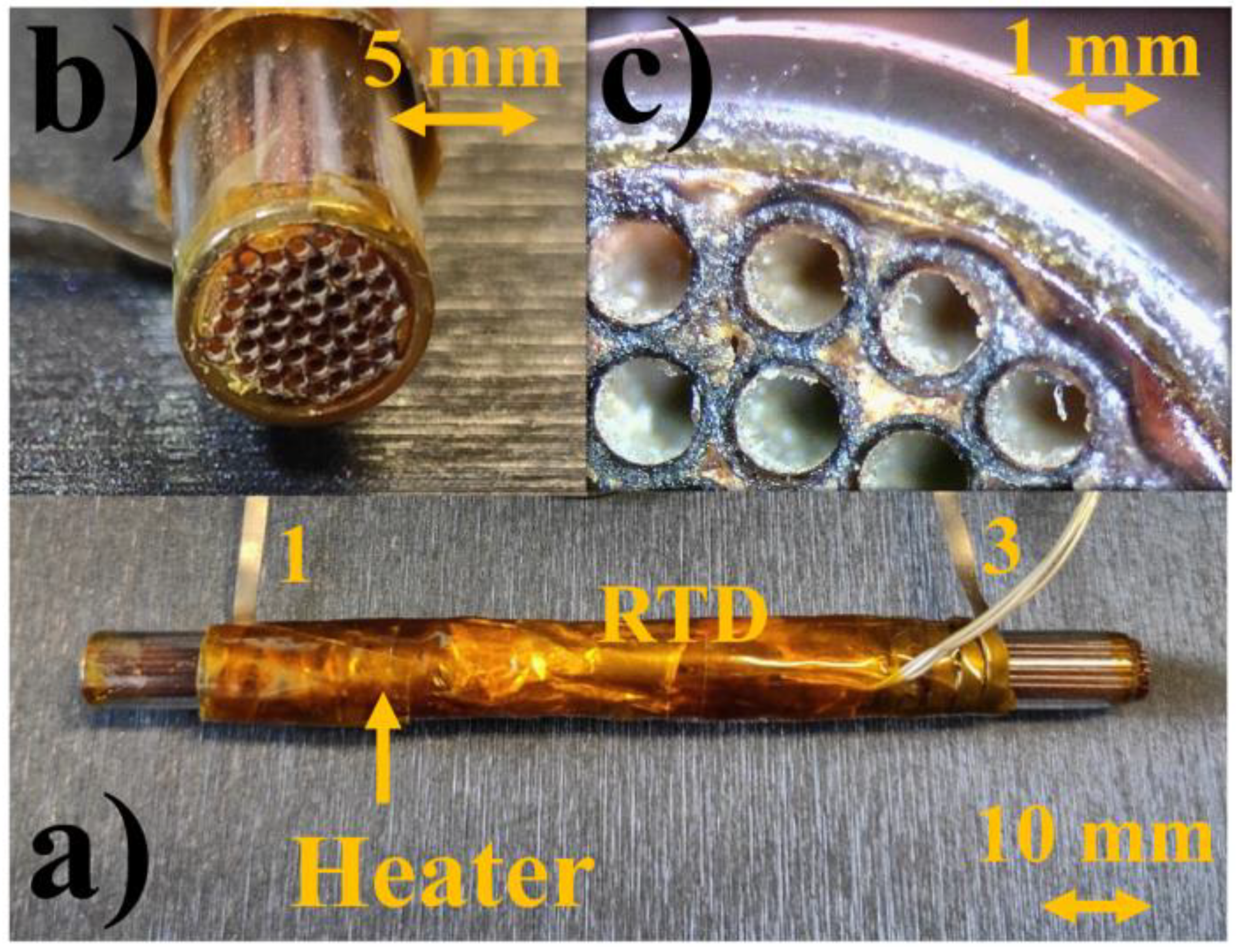
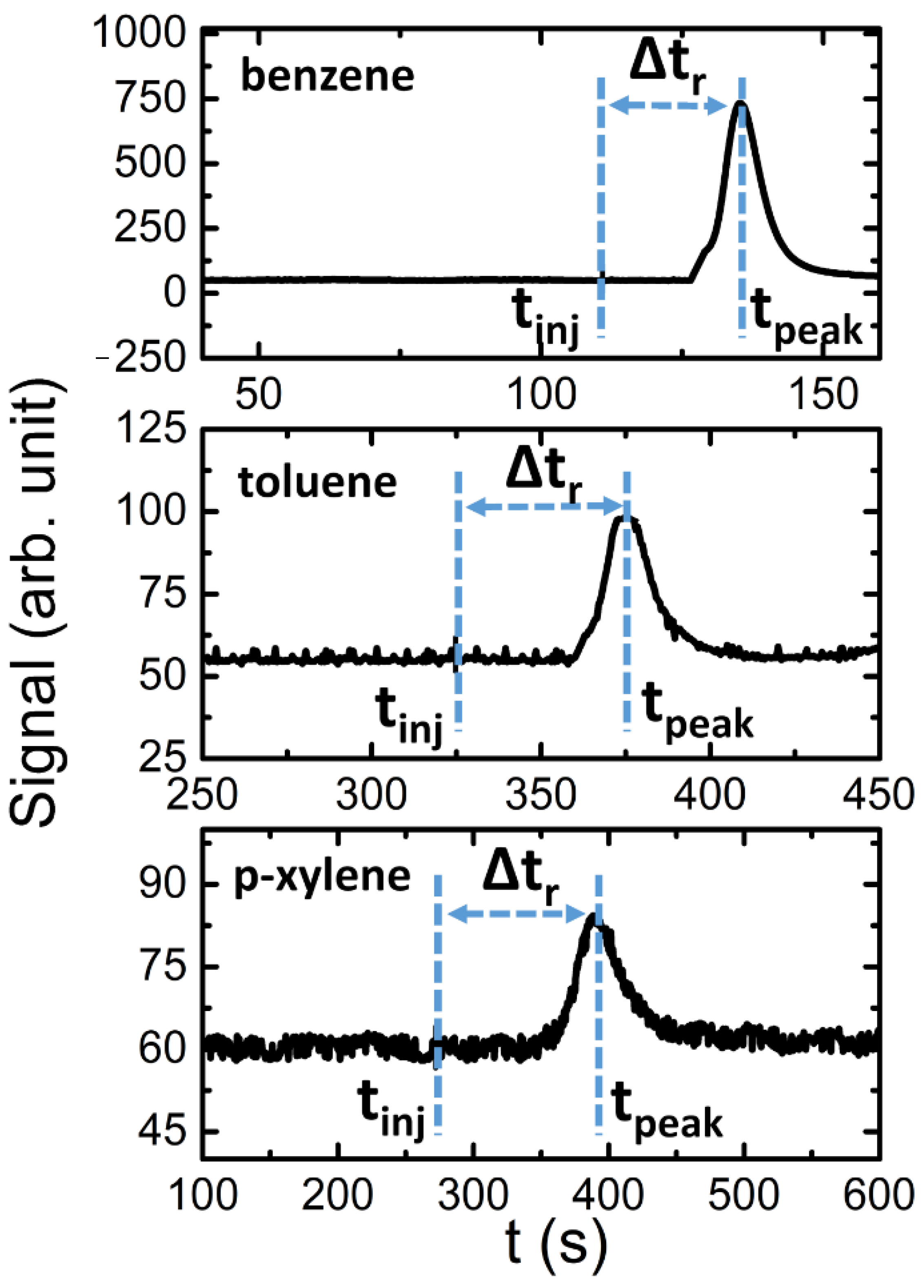
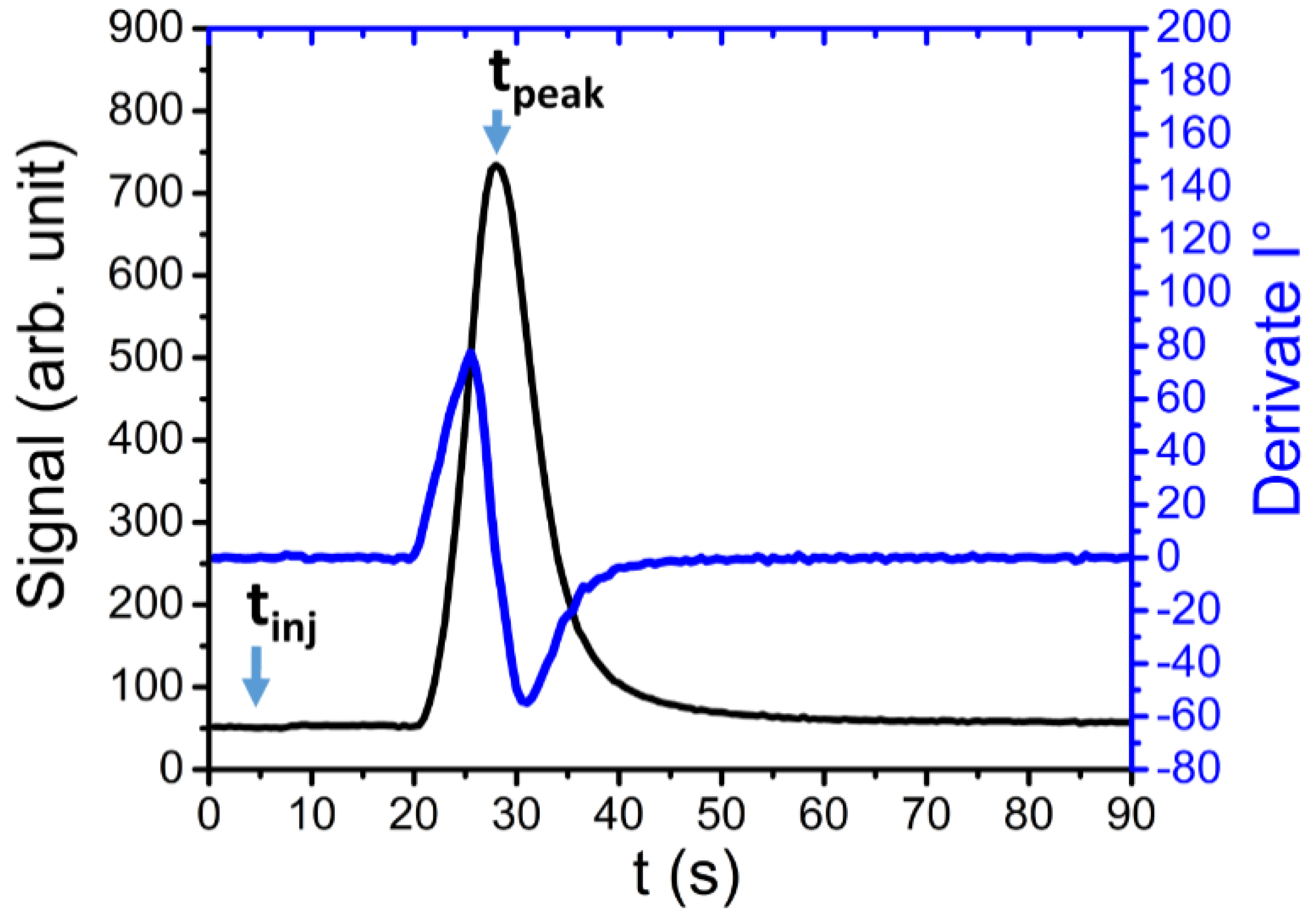

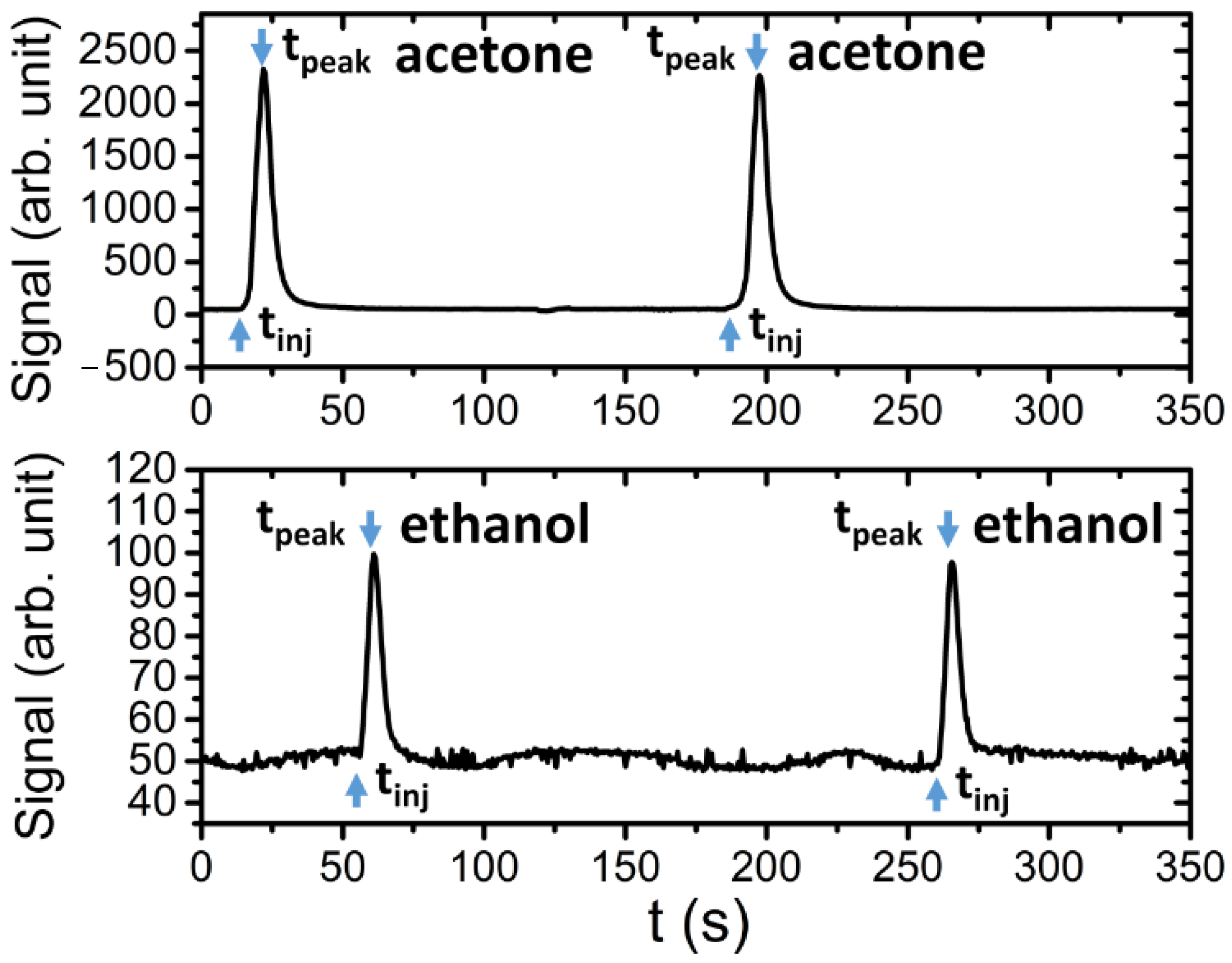
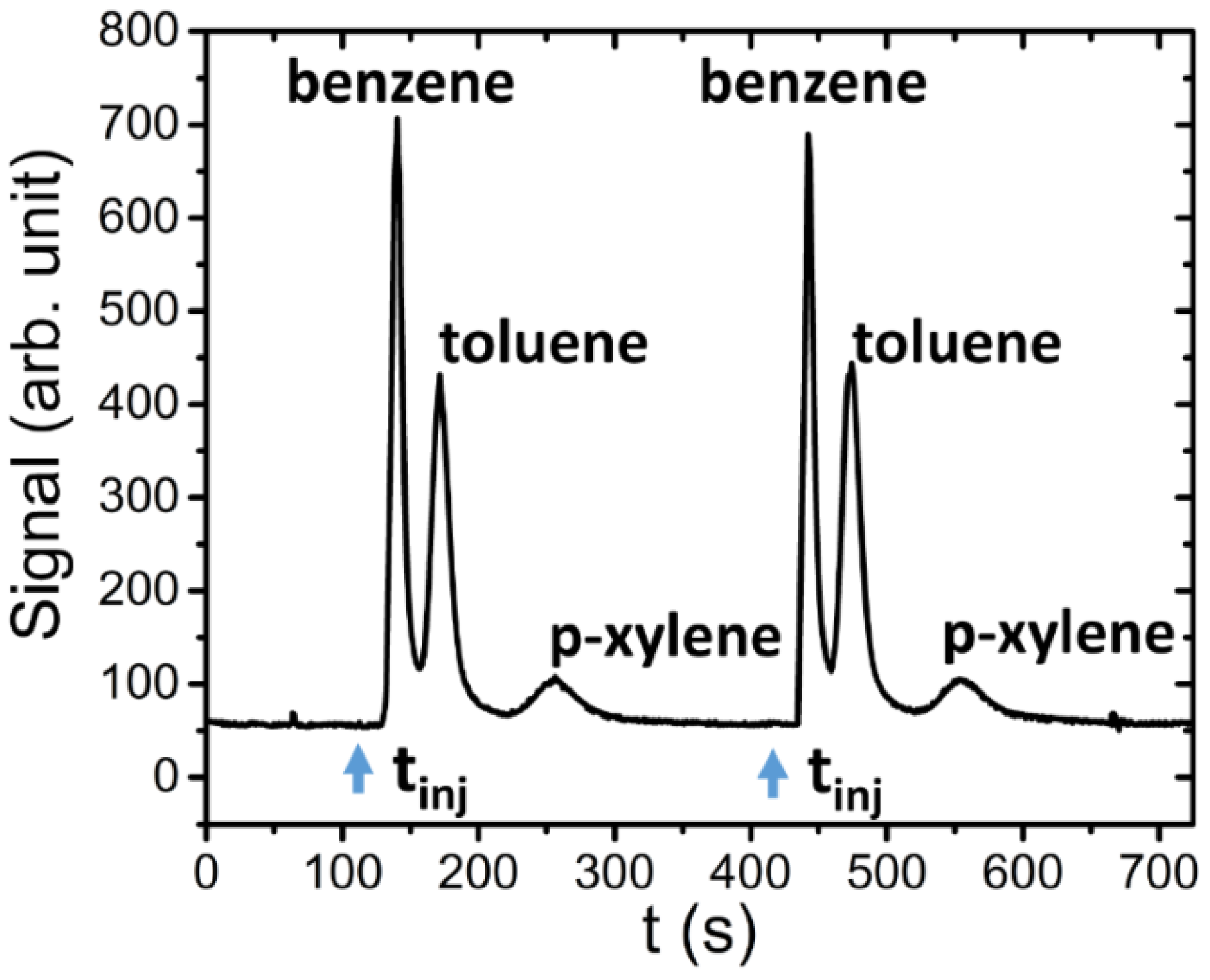

Publisher’s Note: MDPI stays neutral with regard to jurisdictional claims in published maps and institutional affiliations. |
© 2020 by the authors. Licensee MDPI, Basel, Switzerland. This article is an open access article distributed under the terms and conditions of the Creative Commons Attribution (CC BY) license (http://creativecommons.org/licenses/by/4.0/).
Share and Cite
Zampetti, E.; Papa, P.; Avossa, J.; Bearzotti, A.; Balducci, C.; Tranfo, G.; Macagnano, A. Low-Cost Benzene Toluene Xylene Measurement Gas System Based on the Mini Chromatographic Cartridge. Sensors 2021, 21, 125. https://doi.org/10.3390/s21010125
Zampetti E, Papa P, Avossa J, Bearzotti A, Balducci C, Tranfo G, Macagnano A. Low-Cost Benzene Toluene Xylene Measurement Gas System Based on the Mini Chromatographic Cartridge. Sensors. 2021; 21(1):125. https://doi.org/10.3390/s21010125
Chicago/Turabian StyleZampetti, Emiliano, Paolo Papa, Joshua Avossa, Andrea Bearzotti, Catia Balducci, Giovanna Tranfo, and Antonella Macagnano. 2021. "Low-Cost Benzene Toluene Xylene Measurement Gas System Based on the Mini Chromatographic Cartridge" Sensors 21, no. 1: 125. https://doi.org/10.3390/s21010125






